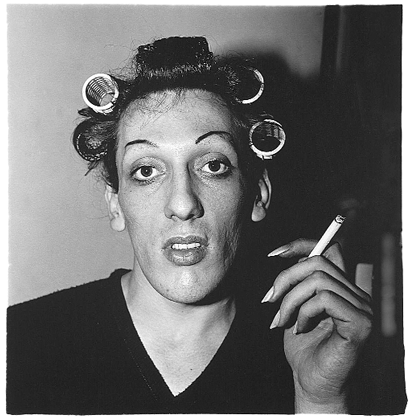Diane Arbus’ photographs include some remarkable pre-Stonewall artifacts
It is telling that one of the first images in the Diane Arbus retrospective at the Metropolitan Museum of Art through May 30 is a nude and heavily pregnant self-portrait, done about 12 years before her mature style evolved. This is a strong image of emotional housecleaning. What is left unseen about the photographer after this completely revealing image?
Well, the Met presents a rich sampling of Arbus’ work but also some dubious thematic lines. So, I went hunting for “family” among the graven images.
“Young Man in Curlers, at Home on West 20th Street, NYC 1966,” a time capsule piece from Chelsea just before Stonewall, tells us more about ourselves as a gay and lesbian community and where we have come from than all of the speeches at Pride ever will. A big, greasy face with plucked eyebrows, curlers, lit cigarette, acrylic V-neck sweater and dirty nails—just how old is Joey Arias, anyway? Using her signature flat-footed composition in the soft square format, Arbus makes a determined point of nearly always photographing her male cross-dressers in the state of transformation between male and female attire. Whether the boys are “show girls” or just putting on for the night, Arbus wants to see them and they want to be looked at—to be seen and to be made visible.
Even “Naked Man being a Woman, NYC 1968,” with his business tucked in and just out of a girdle with visible panty lines, is all contraposto and mugging attitude, ready for his close up, as is the infamous “Seated Man in Bra and Stockings, NYC 1967.”
You just know that “Curlers” was real pretty, all dolled up with his face on.
The transformation theme gets put on hold when Arbus’ subjects are living as the other full time, as in “Transvestite Showing Cleavage, NYC 1966” and “Transvestite on a Couch, NYC 1966.” In both cases, she accepts her subjects just as they are. When she snaps lesbians as in “Girl with a Cigar in Washington Square Park, NYC 1965” or “Miss Storme de Larverice, the Lady who appears to be a Gentleman, NYC,” the transformation is complete, the dream is realized—thin, handsome, well shod, smoking in the park, a different flavor of defiance in the world.
In Central Park, she photographs the well-dressed “Young Man in a Plaid Coat and Toothpick, NYC 1961” and in “Family at Easter, NYC 1956” she summarizes all of the gay coming of age stories that are going to be written over the next 40 years in the face of the young man crushed up on that park bench with his parents. In “Friends in Central Park, NYC 1965” Arbus tosses yet another image to those into spotting gay couples in photographs—you know “friends” like Siegfried and Roy—with an age-inappropriate couple in matching starched white shirts and khakis.
Don’t be put off by the hokey little rooms filled to the brim with Arbus’ personal effects and library and studio/darkroom materials. These displays are a misstep in an exhibition that is premised on separating Arbus’ work from her biography. Why are we in her panty drawer? I can’t imagine that she would be pleased that her pin-board, working prints and notebooks are on display. The cult factory at the Met is certainly revved up full stop for artistic sainthood, that post-modern exercise in rehabbing an artist’s personality for mass consumption and greater cha-ching at the bookstores.
My question is why do the guys get to be bastards—Picasso, DeKooning, to name just two—while the women must be presented and perceived as “nice ladies”? Imogen Cunningham was a “nice lady” photographer, who remembers any of her photographs? Major innovators—and Arbus is surely one—are rarely sweetness and light, regardless of gender, and are generally not salable as personalities.
If Arbus had been less driven, less focused, more socially acceptable, nicer, her work would have suffered. Her gift was that she made it okay to stare, full on, with the hard look. What had been socially invisible became photographically visible. She changed our vision. The work speaks for itself. Simply genuflect to her Rolleiflex camera and move on.
gaycitynews.com


































